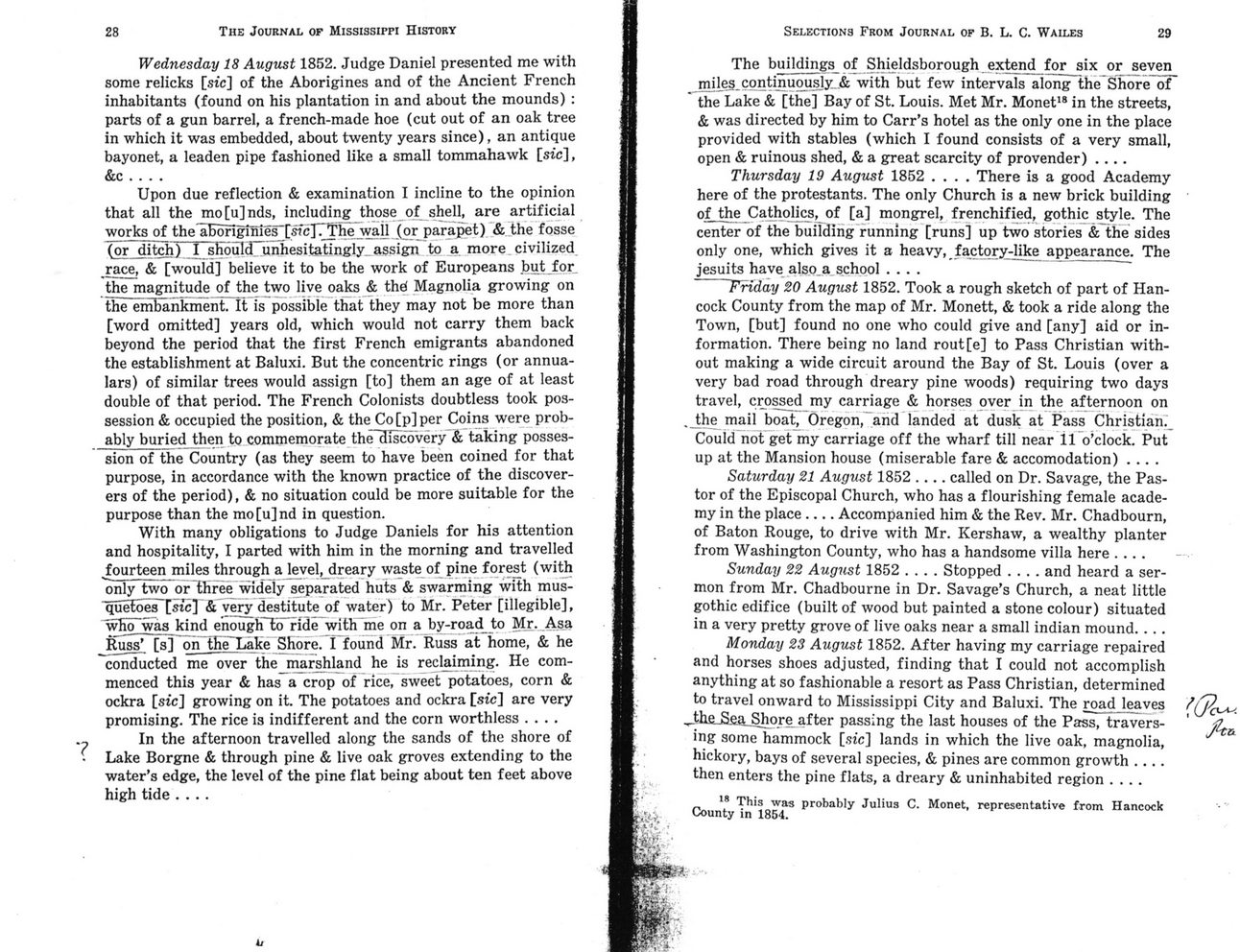This text was obtained via automated optical character recognition.
It has not been edited and may therefore contain several errors.
28 The Journal op Mississippi History Wednesday 18 August 1852. Judge Daniel presented me with some relicks [sic] of the Aborigines and of the Ancient French inhabitants (found on his plantation in and about the mounds) : parts of a gun barrel, a french-made hoe (cut out of an oak tree in which it was embedded, about twenty years since), an antique bayonet, a leaden pipe fashioned like a small tommahawk [sic], &c . . . . Upon due reflection & examination I incline to the opinion that all the mo[u]nds, including those of shell, are artificial works of the aT)originies~[sic]7>rhe waii (or parapet) & the fosse (or ditch) I sh6tfl(T~unhesitatingly. assign to a more civilized race, & [wouid] believe it to be the work of Europeans but for. the magnitude of the two livejpaks & the! Magnolia growing on the embankment. It is possible that they may not be more than [word omitted] years old, which would not carry them back beyond the period that the first French emigrants abandoned the establishment at Baluxi. But the concentric rings (or annua-lars) of similar trees would assign [to] them an age of at least double of that period. The French Colonists doubtless took possession & occupied the position, & the Co [p] per Coins were prob-ably buried then to commemorate the discovery & taking possession of the Country (as they seem to have been coined for that purpose, in accordance with the known practice of the discoverers of the period), & no situation could be more suitable for the purpose than the mo[u]nd in question. With many obligations to Judge Daniels for his attention and hospitality, I parted with him in the morning and travelled ^fourteen miles through a level,_dreary waste of_pine forest (with only two or three widely separated huts & swarming with mus-quetoes [sic] & very destitute of water) to Mr. Peter [illegible], who~wa.s kind enougffYo ride with me on a by-road_to Mr.. Asa Russ' [s] on tHe Lake Shore. I found Mr. Russ at home, & he conducted me over the marshland he is reclaiming. He commenced this year & has a crop of rice, sweet potatoes, corn & ockra [sic] growing on it. The potatoes and ockra [sic] are very promising. The rice is indifferent and the corn worthless .... In the afternoon travelled along the sands of the shore of Lake Borgne & through pine & live oak groves extending to the water?s edge, the level of the pine flat being about ten feet above high tide .... Selections From Journal of B. L. C. Wailes 29 The buildings of Shieldsborough extend for six or seven mjles continuously. .& with but few intervals along the Shore of the Lake & [the] Bay of St. Louis. Met Mr. Monet18 in the streets, & was directed by him to Carr?s hotel as the only one in the place provided with stables (which I found consists of a very small, open & ruinous shed, & a great scarcity of provender) .... Thursday 19 August 1852 .... There is a good Academy here of the protestants. The only Church is a new brick building of the Catholics, of [a] mongrel, frenchified, gothic style. The center of the building?running [runs] up two stories &*the sides only one, which gives it a heavy, factory-like appearance. The jesuits have also.a school .... 'Friday 20 August 1852. Took a rough sketch of part of Hancock County from the map of Mr. Monett, & took a ride along the Town, [but] found no one who could give and [any] aid or information. There being no land rout[e] to Pass Christian without making a wide circuit around the Bay of St. Louis (over a very bad road through dreary pine woods) requiring two days travel, crossed my carriage & horses over Jn the afternoon on . the mail boat^ Oregon,"and landed at dusk at Pass Christian.^ Could not get my carriage off the wharf till near 11 o?clock. Put up at the Mansion house (miserable fare & accomodation) .... Saturday 21 August 1852 .... called on Dr. Savage, the Pastor of the Episcopal Church, who has a flourishing female academy in the place----Accompanied him & the Rev. Mr. Chadbourn, of Baton Rouge, to drive with Mr. Kershaw, a wealthy planter from Washington County, who has a handsome villa here__________ Sunday 22 August 1852 .... Stopped .... and heard a sermon from Mr. Chadbourne in Dr. Savage?s Church, a neat little gothic edifice (built of wood but painted a stone colour) situated in a very pretty grove of live oaks near a small indian mound_____ Monday 23 August 1852. After having my carriage repaired and horses shoes adjusted, finding that I could not accomplish anything at so fashionable a resort as Pass Christian, determined to travel onward to Mississippi City and Baluxi. The road leaves J&fiJka_Shore after passing the last houses of the Pass, traversing some hammock [sic] lands in which the live oak, magnolia, hickory, bays of several species, & pines are common growth .... then enters the pine flats, a dreary & uninhabited region .... 18 This was probably Julius C. Monet, representative from Hancock ixmnty in 1854.

Claiborne, J.F.H Claiborne-J.F.H-107